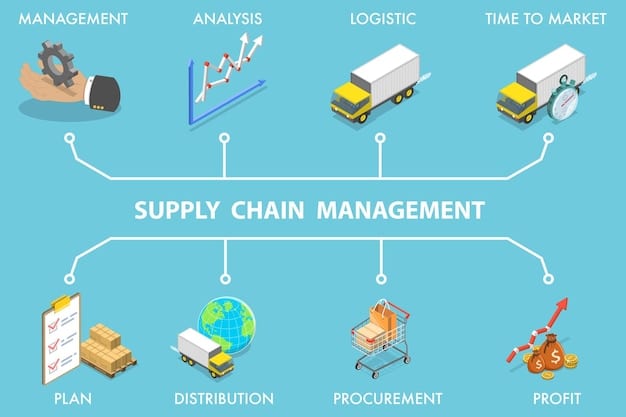Mitigating Global Supply Chain Risks: A Guide for US Businesses

US businesses can mitigate risks associated with global supply chain disruptions by diversifying suppliers, enhancing visibility, building resilience through strategic inventory management, and leveraging technology for improved communication and forecasting.
Global supply chains are facing unprecedented challenges, from geopolitical tensions to natural disasters, impacting US businesses significantly. Understanding **what strategies can US businesses use to mitigate risks associated with global supply chain disruptions** is crucial for ensuring business continuity and maintaining a competitive edge.
Understanding the Landscape of Global Supply Chain Disruptions
The modern global supply chain is a complex web, intricately connecting businesses across continents. Recent events have exposed its vulnerabilities, making it essential for US businesses to understand the landscape of these disruptions.
Global events, such as pandemics, trade wars, and geopolitical instability, can trigger significant disruptions. These events impact various aspects of the supply chain, from raw material sourcing to manufacturing and distribution.
Key Factors Contributing to Supply Chain Vulnerabilities
Several factors contribute to the vulnerabilities of global supply chains. Understanding these factors is crucial for developing effective mitigation strategies.
- Over-reliance on Single Suppliers: Depending on a single supplier, particularly in geographically concentrated areas, increases vulnerability to disruptions.
- Lack of Visibility: Insufficient visibility into the supply chain beyond tier-one suppliers hinders the ability to identify and respond to potential issues.
- Inadequate Risk Management: A reactive approach to risk management, rather than a proactive one, leaves businesses unprepared for unexpected events.
- Geopolitical Risks: Trade tensions, political instability, and regulatory changes in different countries can significantly impact supply chain operations.
By recognizing these vulnerabilities, US businesses can take proactive steps to build more resilient and diversified supply chains, reducing their exposure to potential disruptions.

Diversifying Your Supplier Base
One of the most effective strategies for mitigating supply chain risks is diversifying your supplier base. Over-reliance on a single supplier or region can leave your business vulnerable to disruptions.
Diversification involves sourcing materials and components from multiple suppliers in different geographical locations. This reduces the impact of localized disruptions, ensuring a more stable supply flow.
Benefits of Supplier Diversification
Diversifying your supplier base offers several significant benefits, enhancing your supply chain’s resilience and overall performance.
- Reduced Dependency: Less reliance on a single supplier minimizes the impact of their potential failures or disruptions.
- Increased Flexibility: Access to multiple suppliers allows for greater flexibility in adjusting to changing market conditions and demand.
- Competitive Pricing: Diversification can create competition among suppliers, potentially leading to better pricing and terms.
- Enhanced Innovation: Working with a variety of suppliers can expose your business to new ideas, technologies, and innovations.
Diversifying your supplier base requires thorough research, due diligence, and ongoing supplier relationship management. However, the benefits of increased resilience and flexibility make it a worthwhile investment.
Enhancing Supply Chain Visibility
Visibility is key to proactively identifying and managing potential supply chain disruptions. Enhanced visibility allows businesses to track goods, monitor risks, and respond quickly to unexpected events.
Supply chain visibility involves implementing systems and processes that provide real-time information about the location, status, and condition of goods as they move through the supply chain.
Leveraging Technology for Greater Visibility
Modern technology plays a crucial role in enhancing supply chain visibility.
- IoT (Internet of Things): Sensors and connected devices provide real-time data on the location, temperature, and condition of goods.
- Blockchain: This technology enables secure and transparent tracking of goods and transactions throughout the supply chain.
- AI and Machine Learning: These technologies can analyze vast amounts of data to identify patterns, predict potential disruptions, and optimize supply chain operations.
By leveraging these technologies, US businesses can gain greater visibility into their supply chains, enabling them to proactively manage risks and respond effectively to disruptions.
Building Resilient Inventory Management Strategies
Inventory management plays a critical role in mitigating the impact of supply chain disruptions. Implementing resilient inventory strategies can help businesses maintain adequate stock levels, buffer against unexpected delays, and meet customer demand.
Resilient inventory management involves finding the right balance between holding enough inventory to meet demand and minimizing carrying costs. This requires careful planning, forecasting, and risk assessment.
Strategies for Resilient Inventory Management
Several strategies can help businesses build more resilient inventory management systems.
- Safety Stock: Maintaining a buffer of extra inventory to cover unexpected demand or supply disruptions.
- Strategic Stockpiling: Building up inventory of critical components or materials in anticipation of potential shortages.
- Demand Forecasting: Using data analytics and predictive modeling to improve the accuracy of demand forecasts.
By implementing these strategies, US businesses can better manage their inventory levels, reduce the risk of stockouts, and minimize the impact of supply chain disruptions on customer satisfaction.

Strengthening Communication and Collaboration
Effective communication and collaboration are essential for mitigating supply chain risks. Clear and timely communication among all stakeholders, including suppliers, manufacturers, distributors, and customers, enables businesses to quickly identify and respond to potential disruptions.
Strong relationships with suppliers and partners can improve trust, transparency, and collaboration. This can lead to better information sharing, proactive problem-solving, and more effective risk management.
Building Stronger Relationships with Suppliers
Building stronger relationships with suppliers can significantly improve your supply chain’s resilience.
- Regular Communication: Establish regular communication channels with key suppliers to stay informed about their operations and potential challenges.
- Collaborative Planning: Work with suppliers to develop joint contingency plans and risk mitigation strategies.
- Performance Monitoring: Track supplier performance and provide feedback to help them improve their reliability and responsiveness.
By fostering open communication and collaboration, US businesses can build stronger, more resilient relationships with their suppliers, partners and distributors, enabling them to better navigate supply chain disruptions.
Leveraging Technology for Enhanced Supply Chain Resilience
Technology plays a vital role in enhancing supply chain resilience. Advanced technologies can improve visibility, optimize operations, and enable businesses to respond quickly and effectively to disruptions.
From cloud-based platforms to advanced analytics, technology offers a wide range of solutions for mitigating supply chain risks and improving overall performance.
Key Technologies for Supply Chain Resilience
Several key technologies can significantly enhance supply chain resilience.
- Cloud Computing: Cloud-based platforms provide scalable and accessible data storage, collaboration tools, and applications for supply chain management.
- Artificial Intelligence (AI): AI-powered tools can analyze vast amounts of data to identify patterns, predict potential disruptions, and optimize supply chain operations.
- Real-Time Tracking Systems: Real-time tracking technologies, such as GPS and RFID, provide up-to-the-minute information about the location and status of goods.
By embracing these technologies, US businesses can build more resilient, efficient, and agile supply chains, capable of withstanding disruptions and maintaining a competitive edge.
| Key Element | Brief Description |
|---|---|
| 🛡️ Supplier Diversification | Sourcing from multiple suppliers to reduce dependency risks. |
| 🔍 Enhanced Visibility | Using technology to track goods and monitor risks in real-time. |
| 📦 Inventory Management | Maintaining optimal stock levels through strategic planning and forecasting. |
| 🤝 Communication & Collaboration | Fostering strong relationships and clear communication with all stakeholders. |
Frequently Asked Questions
▼
Supply chain diversification involves sourcing materials and components from multiple suppliers in different geographical locations to reduce risk associated with single-source dependencies.
▼
Technology improves resilience through real-time tracking, data analytics, and AI, enabling businesses to quickly identify and respond to potential disruptions and optimize operations.
▼
Effective communication and collaboration among stakeholders enable businesses to proactively identify risks, share information, and coordinate responses to disruptions, minimizing impact.
▼
Resilient inventory management includes safety stock, strategic stockpiling, and accurate demand forecasting, ensuring businesses can meet demand despite supply chain disruptions.
▼
Businesses can identify vulnerabilities by mapping their supply chain, assessing supplier reliability, monitoring geopolitical risks, and regularly reviewing their risk management strategies.
Conclusion
In conclusion, mitigating risks associated with global supply chain disruptions requires a multifaceted approach. By diversifying suppliers, enhancing visibility, building resilient inventory management strategies, strengthening communication, and leveraging technology, US businesses can build more robust and agile supply chains, capable of weathering disruptions and maintaining a competitive edge in the global marketplace.





